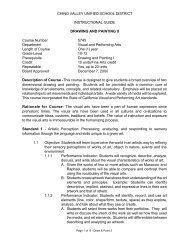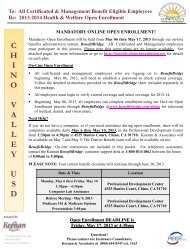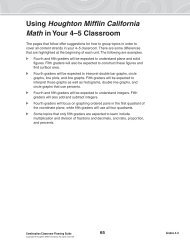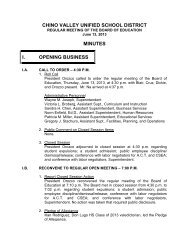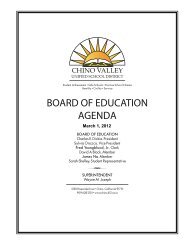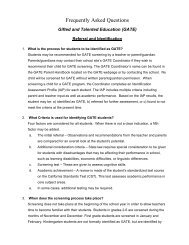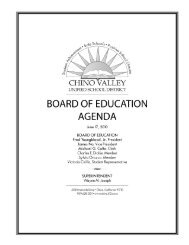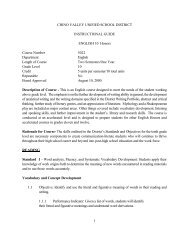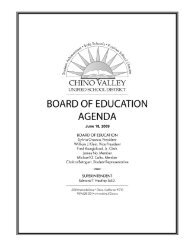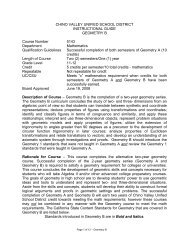For Ruben S. Ayala High - Chino Valley Unified School District
For Ruben S. Ayala High - Chino Valley Unified School District
For Ruben S. Ayala High - Chino Valley Unified School District
Create successful ePaper yourself
Turn your PDF publications into a flip-book with our unique Google optimized e-Paper software.
Executive Summary <strong>School</strong> Accountability Report Card, 2011–12<br />
Published During 2012–13<br />
<strong>For</strong> <strong>Ruben</strong> S. <strong>Ayala</strong> <strong>High</strong><br />
Address: 14255 Peyton Drive, <strong>Chino</strong> Hills, CA 91709 Phone: (909) 627-3584<br />
Principal: Diana Yarboi, Principal Grade Span: 9-12<br />
This executive summary of the <strong>School</strong> Accountability Report Card (SARC) is intended to provide<br />
parents and community members with a quick snapshot of information related to individual public<br />
schools. Most data presented in this report are reported for the 2011–12 school year. <strong>School</strong> finances<br />
and school completion data are reported for the 2010–11 school year. Contact information, facilities,<br />
curriculum and instructional materials, and select teacher data are reported for the 2012–13 school<br />
year. <strong>For</strong> additional information about the school, parents and community members should review the<br />
entire SARC or contact the school principal or the district office.<br />
About This <strong>School</strong><br />
<strong>Ruben</strong> S. <strong>Ayala</strong> <strong>High</strong> <strong>School</strong>, a comprehensive secondary school recognized for a tradition of<br />
excellence since its opening in San Bernardino County in 1990, serves students in the ninth<br />
through twelfth grades. These students come from a diverse, well educated, middle-class to<br />
upper-middle-class community. The students of <strong>Ayala</strong> <strong>High</strong> participate in a rigorous academic<br />
curriculum and many partake of the school's extended co-curricular and extracurricular<br />
opportunities. <strong>Ayala</strong>'s educational program consists of three parts: 1) academics, 2) cocurricular<br />
activities, and 3) extra-curricular activities. Parent and community support for the<br />
school run high, as does student and parental involvement. The school's highly qualified and<br />
talented staff supports our students as they progress through school and prepare for the<br />
responsibilities of citizenship and adulthood.<br />
Student Enrollment<br />
Group Enrollment<br />
Number of students 2,500<br />
Black or African American 4.0%<br />
American Indian or Alaska Native 0.3%<br />
Asian 21.4%<br />
Filipino 8.5%<br />
Hispanic or Latino 30.8%<br />
Native Hawaiian or Pacific Islander 0.4%<br />
White 32.6%<br />
Two or More Races 2.1%<br />
Socioeconomically Disadvantaged 16.0%<br />
English Learners 6.7%<br />
Students with Disabilities 11.9%
Teachers<br />
Indicator Teachers<br />
Teachers with full credential 94<br />
Teachers without full credential 0<br />
Teachers Teaching Outside Subject Area of Competence 4<br />
Misassignments of Teachers of English Learners 0<br />
Total Teacher Misassignments 0<br />
Student Performance<br />
Subject Students Proficient and Above on STAR* Program Results<br />
English-Language Arts 74%<br />
Mathematics 49%<br />
Science 73%<br />
History-Social Science 57%<br />
*Standardized Testing and Reporting Program assessments used for accountability purposes include<br />
the California Standards Tests, the California Modified Assessment, and the California Alternate<br />
Performance Assessment.<br />
Academic Progress*<br />
Indicator Result<br />
2012 Growth API Score (from 2012 Growth API Report) 845<br />
Statewide Rank (from 2011 Base API Report) 9<br />
Met All 2012 AYP Requirements no<br />
Number of AYP Criteria Met Out of the Total Number of Criteria Possible<br />
2012–13 Program Improvement Status (PI Year)<br />
Met 15 of 18<br />
*The Academic Performance Index is required under state law. Adequate Yearly Progress is required<br />
by federal law.<br />
<strong>School</strong> Facilities<br />
Summary of Most Recent Site Inspection<br />
Safety concerns are the number one priority of <strong>Chino</strong> <strong>Valley</strong> Maintenance and Operations<br />
department. <strong>District</strong> maintenance supervisors are proactive and conduct inspections at school<br />
sites on a continual basis. Our school provides a safe, clean environment for students, staff,<br />
and volunteers. Classrooms, bathrooms, and general areas are in GOOD repair and receive<br />
basic cleaning on a daily basis. Detailed cleaning is done during vacation periods.<br />
The <strong>Chino</strong> <strong>Valley</strong> <strong>Unified</strong> <strong>School</strong> <strong>District</strong> conducted a Facility Inspection Tool (FIT) inspection at<br />
<strong>Ayala</strong> <strong>High</strong> <strong>School</strong> in July 2012. The findings of this inspection rated the school in GOOD<br />
working order. This inspection includes systems (ie: gas leaks, mechanical, HVAC, sewer),<br />
interior (ie: surfaces), cleanliness (ie: overall cleanliness, pest/vermin infestation), electrical,<br />
restrooms/fountains, safety (ie: fire safety, hazardous materials), structural (ie: damage,<br />
roofs), external (ie: playground, school grounds, windows, doors, gates, fences).
Repairs Needed<br />
The <strong>District</strong> administers a scheduled maintenance program to support the educational process<br />
by maintaining a safe and healthy learning and teaching environment. The district provides<br />
routine maintenance, preventative maintenance, and minor construction-type projects.<br />
Corrective Actions Taken or Planned<br />
Daily reports of incidents that require repair at the school sites are processed through work<br />
orders. Emergency repairs are given the highest priority. The remaining incidents are handled<br />
on a first-come, first-served basis to ensure efficient service.<br />
Curriculum and Instructional Materials<br />
Core Curriculum Area<br />
Pupils Who Lack Textbooks<br />
Instructional Materials<br />
and<br />
Reading/Language Arts 0<br />
Mathematics 0<br />
Science 0<br />
History-Social Science 0<br />
<strong>For</strong>eign Language 0<br />
Health 0<br />
Visual and Performing Arts 0<br />
Science Laboratory Equipment (grades 9-12) 0<br />
<strong>School</strong> Finances<br />
Level Expenditures Per Pupil (Unrestricted Sources Only)<br />
<strong>School</strong> Site $5,828<br />
<strong>District</strong> $7,645<br />
State $5,455<br />
<strong>School</strong> Completion<br />
Indicator Result<br />
Graduation Rate (if applicable) 92.30<br />
Postsecondary Preparation<br />
Measure Percent<br />
Pupils Who Completed a Career Technical Education Program and Earned a <strong>High</strong> <strong>School</strong><br />
93.0%<br />
Diploma<br />
Graduates Who Completed All Courses Required for University of California or California<br />
48.4%<br />
State University Admission
<strong>School</strong> Accountability Report Card<br />
Reported Using Data from the 2011–12 <strong>School</strong> Year<br />
Published During 2012–13<br />
<strong>Ruben</strong> S. <strong>Ayala</strong> <strong>High</strong><br />
Every school in California is required by state law to publish a <strong>School</strong> Accountability Report Card<br />
(SARC), by February 1 of each year. The SARC contains information about the condition and<br />
performance of each California public school.<br />
<strong>For</strong> more information about SARC requirements, see the California Department of Education (CDE)<br />
SARC Web page at http://www.cde.ca.gov/ta/ac/sa/.<br />
<strong>For</strong> additional information about the school, parents and community members should contact the<br />
school principal or the district office.<br />
Data and Access<br />
Ed-Data Partnership Web Site<br />
Ed-Data is a partnership of the CDE, EdSource, and the Fiscal Crisis and Management Assistance Team<br />
(FCMAT) that provides extensive financial, demographic, and performance information about<br />
California’s public kindergarten through grade twelve school districts and schools.<br />
DataQuest<br />
DataQuest is an online data tool located on the CDE DataQuest Web page at<br />
http://dq.cde.ca.gov/dataquest/ that contains additional information about this school and<br />
comparisons of the school to the district, the county, and the state. Specifically, DataQuest is a<br />
dynamic system that provides reports for accountability (e.g., state Academic Performance Index<br />
[API], federal Adequate Yearly Progress [AYP]), test data, enrollment, high school graduates,<br />
dropouts, course enrollments, staffing, and data regarding English learners.<br />
Internet Access<br />
Internet access is available at public libraries and other locations that are publicly accessible (e.g., the<br />
California State Library). Access to the Internet at libraries and public locations is generally provided<br />
on a first-come, first-served basis. Other use restrictions may include the hours of operation, the<br />
length of time that a workstation may be used (depending on availability), the types of software<br />
programs available on a workstation, and the ability to print documents.<br />
About This <strong>School</strong><br />
Contact Information (<strong>School</strong> Year 2012–13)<br />
<strong>School</strong> <strong>District</strong><br />
<strong>School</strong> Name <strong>Ruben</strong> S. <strong>Ayala</strong> <strong>High</strong> <strong>District</strong> Name <strong>Chino</strong> <strong>Valley</strong> <strong>Unified</strong><br />
Street 14255 Peyton Drive Phone Number (909) 628-1201<br />
City, State, Zip <strong>Chino</strong> Hills, CA 91709 Web Site www.chino.k12.ca.us<br />
Phone Number (909) 627-3584 Superintendent Wayne Joseph<br />
Principal Diana Yarboi, Principal E-mail Address wayne_joseph@chino.k12.ca.us<br />
E-mail Address diana_yarboi@chino.k12.ca.us CDS Code 36-67678-3630522
<strong>School</strong> Description and Mission Statement<br />
Located in <strong>Chino</strong> Hills, the strong academic image of <strong>Ayala</strong> <strong>High</strong> <strong>School</strong> reinforces the value of<br />
education and instills a sense of community pride in the faculty. The heart of the school, and<br />
meeting place for the student body, is a tree-lined quadrangle with eight academic buildings<br />
directly across a 600-foot lawn area. Paths throughout the quadrangle lead to classrooms in<br />
the academic buildings and in 45 portable classrooms. The <strong>Ayala</strong> <strong>High</strong> <strong>School</strong> staff, in<br />
cooperation with the community, is dedicated to providing opportunities for all students to<br />
achieve in a safe and positive environment. We value our students as unique individuals and<br />
believe that involvement in academic, arts, guidance, vocational, athletics, and activity<br />
programs is key to a successful high school experience and productive life. Our students will<br />
develop critical thinking and decision making skills, gain respect for individual differences,<br />
have a sense of purpose and direction in their own lives and leave as life long learners who will<br />
be knowledgeable and responsible citizens.<br />
Opportunities for Parental Involvement<br />
Approximately 1000 of our parent community are involved with booster groups, PTSA, <strong>School</strong><br />
Site Council, and parent support organizations. Business and community partnerships include<br />
the McCoy Equestrian center, our Engineering and Construction Academies, <strong>Chino</strong> Hills <strong>For</strong>d,<br />
Staples, and numerous other collaborative community groups. <strong>Chino</strong> Adult <strong>School</strong> and Chaffey<br />
College classes are offered on our campus.<br />
Student Enrollment by Grade Level (<strong>School</strong> Year 2011–12)<br />
Grade Level Number of Students<br />
Grade 9 640<br />
Grade 10 623<br />
Grade 11 611<br />
Grade 12 626<br />
Total Enrollment 2,500<br />
Student Enrollment by Student Group (<strong>School</strong> Year 2011-12)<br />
Group Percent of Total Enrollment<br />
Black or African American 4.0%<br />
American Indian or Alaska Native 0.3%<br />
Asian 21.4%<br />
Filipino 8.5%<br />
Hispanic or Latino 30.8%<br />
Native Hawaiian or Pacific Islander 0.4%<br />
White 32.6%<br />
Two or More Races 2.1%<br />
Socioeconomically Disadvantaged 16.0%<br />
English Learners 6.7%<br />
Students with Disabilities 11.9%
Average Class Size and Class Size Distribution (Secondary)<br />
Subject<br />
Avg.<br />
Class<br />
Size<br />
2009–10<br />
Number of<br />
Classes<br />
1-<br />
22<br />
23-<br />
32<br />
33+<br />
Avg.<br />
Class<br />
Size<br />
2010–11<br />
Number of<br />
Classes<br />
1-<br />
22<br />
23-<br />
32<br />
33+<br />
Avg.<br />
Class<br />
Size<br />
2011–12<br />
Number of<br />
Classes<br />
English 28.5 13 37 33 30.0 8 30 37 31.6 9 14 48<br />
Mathematics 28.2 13 35 24 28.3 12 31 28 31.3 8 17 41<br />
Science 30.2 5 25 17 31.6 1 19 27 32.3 3 8 38<br />
Social<br />
Science<br />
29.1 7 36 18 31.8 3 30 34 32.7 6 10 46<br />
1-<br />
22<br />
23-<br />
32<br />
33+
<strong>School</strong> Climate<br />
<strong>School</strong> Safety Plan<br />
<strong>Ayala</strong> <strong>High</strong> <strong>School</strong> has a detailed <strong>School</strong> Site Safety Plan for emergencies. Each staff member<br />
is assigned a specific responsibility in the event of an emergency. Staff members are trained in<br />
the plan’s components and procedures. Fire, earthquake, and intruder drills are held on a<br />
regular basis so that all students and staff are familiar with emergency procedures. Emergency<br />
supplies are located on each campus in the event of an emergency.<br />
Assigned staff monitors school grounds daily before, during, and after school. The <strong>District</strong><br />
policy regarding campus visitors is enforced by requiring everyone to check in at the school<br />
office and obtain a visitor’s badge. A visitor sign-in log is located in the school office and all<br />
visitors must sign in before going onto the campus. In addition, all visitors must wear an<br />
identifying badge while on campus. To increase security, all gates remain locked during the<br />
school day, so visitors must enter campus through the school office.<br />
The <strong>Chino</strong> <strong>Valley</strong> <strong>Unified</strong> <strong>School</strong> <strong>District</strong> is committed to providing an environment that fosters<br />
health and safety, in both form and function. This commitment extends to the process of<br />
developing and maintaining a comprehensive Emergency and Disaster Preparedness Plan as a<br />
part of the <strong>District</strong>’s Safe <strong>School</strong>s Plan and is evident from the individual site to the overall<br />
<strong>District</strong>.<br />
These plans delineate actions to protect all students while they are at school. The plans are<br />
designed with the help of security staff members, local law enforcement, local fire, and<br />
emergency management, and public health officials as required by Education Code 32280-<br />
32282. Plans are reviewed and updated yearly in accordance with Education Code 32286.<br />
These plans include procedures to respond to critical incidents, such as fire, earthquake, or<br />
intruders. <strong>School</strong> personnel practice these drills regularly.<br />
The primary purpose of the <strong>Chino</strong> <strong>Valley</strong> <strong>Unified</strong> <strong>School</strong> <strong>District</strong> Emergency and Disaster<br />
Preparedness Plan is to define roles and responsibilities at the site and between the site and<br />
district office management. The Emergency and Disaster Preparedness Plan establishes the<br />
minimum requirements for school and site plans throughout the <strong>District</strong>. This Plan meets the<br />
requirements of the Standardized Emergency Management System (SEMS) as mandated by<br />
California Code of Regulations, Sections 2400-2450, and the National Incident Management<br />
System (NIMS) as mandated by Government Code 8607. It also meets the requirements for<br />
earthquake preparedness found in Title 5 (California State Education Code, Sections 35295-<br />
35297).<br />
Suspensions and Expulsions<br />
Rate*<br />
<strong>School</strong><br />
2009–10<br />
<strong>School</strong><br />
2010–11<br />
<strong>School</strong><br />
2011–12<br />
<strong>District</strong><br />
2009–10<br />
<strong>District</strong><br />
2010–11<br />
<strong>District</strong><br />
2011–12<br />
Suspensions 0.08% 3.17% 1.72% 0.25% 6.45% 11.35%<br />
Expulsions 0.00% 0.16% 0.00% 0.43% 0.24% 0.00%<br />
* The rate of suspensions and expulsions is calculated by dividing the total number of incidents by the<br />
total enrollment.
<strong>School</strong> Facilities<br />
<strong>School</strong> Facility Conditions and Planned Improvements<br />
<strong>Ayala</strong> <strong>High</strong> <strong>School</strong> provides a safe, clean environment for students, staff, and volunteers. <strong>School</strong> facilities<br />
were build in 1990 and includes the multi purpose room, kitchen, office, staff workrooms, library, gym,<br />
66 permanent classrooms and 45 portables, which provide adequate space for students and staff.<br />
Custodians ensure classrooms, restrooms, and campus grounds are kept clean and safe. <strong>Chino</strong> <strong>Valley</strong><br />
<strong>Unified</strong> administers a scheduled maintenance program to ensure that all classrooms and facilities are<br />
well-maintained and provide an environment that is conducive to learning.<br />
<strong>Ayala</strong> complies with all laws, rules, and regulations pertaining to hazardous materials and State<br />
earthquake standards. Our school’s disaster preparedness plan includes steps for ensuring student and<br />
staff safety during a disaster. Fire drills are held monthly and disaster drills are held twice a year.<br />
<strong>Chino</strong> <strong>Valley</strong> <strong>Unified</strong> <strong>School</strong> <strong>District</strong> Summer 2008 construction and maintenance projects included slurry<br />
coat and seal for <strong>Ayala</strong> <strong>High</strong> <strong>School</strong>. In addition the Spring 2009 projects include epoxy coating of the<br />
pool deck and rekeying all exterior gates.<br />
Safety concerns are the number one priority of <strong>Chino</strong> <strong>Valley</strong> Maintenance and Operations department.<br />
<strong>District</strong> maintenance supervisors are proactive and conduct inspections at school sites on a continual<br />
basis. Our school provides a safe, clean environment for students, staff, and volunteers. Classrooms,<br />
bathrooms, and general areas are in GOOD repair and receive basic cleaning on a daily basis. Detailed<br />
cleaning is done during vacation periods.<br />
The <strong>Chino</strong> <strong>Valley</strong> <strong>Unified</strong> <strong>School</strong> <strong>District</strong> conducted a Facility Inspection Tool (FIT) inspection at <strong>Ayala</strong> in<br />
July 2012. The findings of this inspection rated the school in GOOD working order. The chart below lists<br />
any repairs identified in the inspection and the action taken.<br />
<strong>School</strong> Facility Good Repair Status (<strong>School</strong> Year 2012–13)<br />
System Inspected<br />
Systems: Gas Leaks,<br />
Mechanical/HVAC, Sewer<br />
X<br />
Interior: Interior Surfaces X<br />
Cleanliness: Overall<br />
Cleanliness, Pest/ Vermin<br />
Infestation<br />
Repair Status<br />
Good Fair Poor<br />
Electrical: Electrical X<br />
Restrooms/Fountains:<br />
Restrooms, Sinks/ Fountains<br />
X<br />
Safety: Fire Safety, Hazardous<br />
Materials<br />
X<br />
Structural: Structural Damage,<br />
Roofs<br />
External: Playground/<strong>School</strong><br />
X<br />
Grounds, Windows/<br />
Doors/Gates/Fences<br />
X<br />
Overall Rating X<br />
X<br />
Repair Needed and Action Taken or<br />
Planned<br />
Rooms 123, D136, band room, F126, F127, F128, F131, H130,<br />
H132, H133, gym, boys locker, H118, H101, A136, C102,<br />
C106, C107, C108, C109, C110, C111, C112, C113, men’s<br />
restroom, women’s restroom, hallway, G131: accumulated<br />
refuse, dirt, grime. Addressed by Principal<br />
Rooms B125, B104, B106: moss/mold is evident. Addressed by<br />
principal.
Teachers<br />
Teacher Credentials<br />
Teachers<br />
<strong>School</strong><br />
2009–10<br />
<strong>School</strong><br />
2010–11<br />
<strong>School</strong><br />
2011–12<br />
<strong>District</strong><br />
2011–12<br />
With Full Credential 92 97 94 1187<br />
Without Full Credential 0 0 0 1<br />
Teaching Outside Subject Area of Competence<br />
(with full credential)<br />
18 18 4 18<br />
Teacher Misassignments and Vacant Teacher Positions<br />
Indicator 2010–11 2011–12 2012–13<br />
Misassignments of Teachers of English Learners 8 0 2<br />
Total Teacher Misassignments* 0 0 0<br />
Vacant Teacher Positions 16 0 0<br />
Note: “Misassignments” refers to the number of positions filled by teachers who lack legal authorization to teach<br />
that grade level, subject area, student group, etc.<br />
* Total Teacher Misassignments includes the number of Misassignments of Teachers of English Learners.<br />
Core Academic Classes Taught by <strong>High</strong>ly Qualified Teachers (<strong>School</strong> Year 2011–12)<br />
The Federal Elementary and Secondary Education Act (ESEA), also known as No Child Left Behind (NCLB), requires<br />
that core academic subjects be taught by <strong>High</strong>ly Qualified Teachers, defined as having at least a bachelor’s degree,<br />
an appropriate California teaching credential, and demonstrated core academic subject area competence. <strong>For</strong> more<br />
information, see the CDE Improving Teacher and Principal Quality Web page at: http://www.cde.ca.gov/nclb/sr/tq/<br />
Location of Classes<br />
Percent of Classes In<br />
Core Academic Subjects<br />
Taught by <strong>High</strong>ly<br />
Qualified Teachers<br />
Percent of Classes In<br />
Core Academic Subjects<br />
Not Taught by <strong>High</strong>ly<br />
Qualified Teachers<br />
This <strong>School</strong> 98.86% 1.14%<br />
All <strong>School</strong>s in <strong>District</strong> 99.78% 0.22%<br />
<strong>High</strong>-Poverty <strong>School</strong>s in <strong>District</strong> 100.00% 0.00%<br />
Low-Poverty <strong>School</strong>s in <strong>District</strong> 99.47% 0.53%<br />
Note: <strong>High</strong>-poverty schools are defined as those schools with student eligibility of approximately 40 percent or<br />
more in the free and reduced price meals program. Low-poverty schools are those with student eligibility of<br />
approximately 25 percent or less in the free and reduced price meals program.
Support Staff<br />
Academic Counselors and Other Support Staff (<strong>School</strong> Year 2011–12)<br />
Title Number of FTE* Assigned to <strong>School</strong><br />
Academic Counselor 4<br />
Counselor (Social/Behavioral or Career Development)<br />
Library Media Teacher (librarian) 1 districtwide<br />
Library Media Services Staff (paraprofessional)<br />
Psychologist Based on caseload<br />
Social Worker<br />
Nurse 1<br />
Speech/Language/Hearing Specialist Based on caseload<br />
Resource Specialist (non-teaching) Based on caseload<br />
* One Full-Time Equivalent (FTE) equals one staff member working full-time; one FTE could also represent two<br />
staff members who each work 50 percent of full-time.
Curriculum and Instructional Materials<br />
Quality, Currency, Availability of Textbooks and Instructional Materials (<strong>School</strong> Year 2012–13)<br />
This section describes whether the textbooks and instructional materials used at the school are from the most<br />
recent adoption; whether there are sufficient textbooks and instruction materials for each student; and information<br />
about the school’s use of any supplemental curriculum or non-adopted textbooks or instructional materials.<br />
Year and month in which data were collected: October 4, 2012<br />
Core<br />
Curriculum<br />
Area<br />
Reading/<br />
Language Arts<br />
Mathematics<br />
Science<br />
History-Social<br />
Science<br />
<strong>For</strong>eign<br />
Language<br />
Textbooks and instructional materials/year of<br />
adoption<br />
Prentice Hall – Timeless Voices/Timeless Themes, California Edition,<br />
2000, 9-12<br />
Holt Reinhart Winston -- Holt's California Mathematics, Course 1;<br />
Numbers to Algebra, 2008<br />
Holt Reinhart Winston – Mathematics Course 2 pre-Algebra, 2008<br />
Holt Reinhart Winston – Geometry, 2008<br />
Holt Reinhart Winston – Algebra 2, 2008<br />
Person Prentice Hall – Algebra & Trigonometry 8th Edition, 2008<br />
Person Prentice Hall – PreCalculus, 2010<br />
Houghton Mifflin Harcourt – PreCalculus with Limits, 2007<br />
Person Prentice Hall – Calculus 3rd Edition, 2007<br />
Pearson Addison Wesley – Stats Modeling World 2nd Edition, 2007<br />
Pearson Prentice Hall – Earth Science, 2006, 9-12<br />
Pearson Prentice Hall – Biology, 2007, 9-12<br />
Pearson Prentice Hall – Chemistry, 2007, 10-12<br />
Glencoe – Physics: Principles and Problems, 2008, 11-12<br />
Wiley – Environmental Science:Earth as a Living Planet, 2007, 11-12<br />
Pearson prentice Hall – Physical Science: Concepts in Action w/earth<br />
and Space Science, 2009, 9-12<br />
Glencoe – US Government: Democracy in Action, 2006, 12<br />
McDougal – American Government: Institutions & Policies, 2006, 12<br />
Holt – American Anthem: Modern American History, 2007, 11<br />
Bedford – America’s History, 2007, 11<br />
Prentice Hall – Economics: Principles in Action, 2007, 12<br />
Prentice Hall – Foundations of Economics, 2007, 12<br />
Prentice Hall – World History: The Modern World, 2007, 10<br />
Spinner Publications, Inc. – Bom Dia! 2, 2007, 9-12<br />
Prentice Hall – Abriendo Paso: Gramatica and Lectura, 2007, 9-12<br />
EMC/Paradigm Publishers – C’est a Toi! Levels 1, 2, & 3, 2002, 9-12<br />
Sign Media Inc. – Master American Sign Language, 2006, 9-12<br />
Prentice Hall – Realidades, Books 1 & 2, 2004, 9-12<br />
Harcourt – Nuevas Vista, Books 1 & 2, 2003, 9-12<br />
Wayside Publishing – Azulejo, 2002, 9-12<br />
Holt – Komm Mit!, Books 1, 2, & 3, 2003, 9-12<br />
Cheng – Adventures in Japanese, Books 1 and 2, 9-12<br />
From<br />
most<br />
recent<br />
adoption<br />
Yes 0%<br />
Yes 0%<br />
Yes 0%<br />
Yes 0%<br />
Yes 0%<br />
Health McGraw Hill Company – Glencoe Health, 2009, 9-12 Yes 0%<br />
Percent<br />
students<br />
lacking<br />
own<br />
assigned<br />
copy<br />
Textbooks in the core curriculum areas are selected from State adopted lists of approved standards-based<br />
materials. The State Board establishes the adoption cycle for new books, which is followed by the <strong>District</strong>.<br />
Materials being considered for adoption are previewed, evaluated and often piloted by teachers and<br />
administrators, and are subsequently approved by the Board of Education. Textbooks are purchased for each<br />
student for use in class and to take home. Students have access to instructional materials in a variety of<br />
instructional formats, including workbooks and CD ROMs, as well as formats tailored to students who are visually<br />
impaired.<br />
The <strong>Chino</strong> <strong>Valley</strong> <strong>Unified</strong> <strong>School</strong> <strong>District</strong> held a public hearing on October 4, 2012, adopting a resolution<br />
concerning the sufficiency of instructional materials. It was determined that each pupil in each school has<br />
sufficient textbooks that are aligned to the content standards in the core subject areas for the 2012-2013 school<br />
year.
<strong>School</strong> Finances<br />
Expenditures per Pupil and <strong>School</strong> Site Teacher Salaries (Fiscal Year 2010–11)<br />
Level<br />
Total<br />
Expenditures<br />
Per Pupil<br />
Expenditures Per<br />
Pupil (Supplemental<br />
/ Restricted)<br />
Expenditures Per<br />
Pupil (Basic /<br />
Unrestricted)<br />
Average<br />
Teacher<br />
Salary<br />
<strong>School</strong> Site $7,814 $1,986 $5,828 $73,317<br />
<strong>District</strong> $7,645 $72,759<br />
State $5,455 $68,835<br />
Note: Cells shaded in black do not require data.<br />
Supplemental/Restricted expenditures come from money whose use is controlled by law or by a donor. Money<br />
that is designated for specific purposes by the district or governing board is not considered restricted.<br />
Basic/unrestricted expenditures are from money whose use, except for general guidelines, is not controlled by<br />
law or by a donor.<br />
<strong>For</strong> detailed information on school expenditures for all districts in California, see the CDE Current Expense of<br />
Education & Per-pupil Spending Web page at http://www.cde.ca.gov/ds/fd/ec/. <strong>For</strong> information on teacher salaries<br />
for all districts in California, see the CDE Certificated Salaries & Benefits Web page at<br />
http://www.cde.ca.gov/ds/fd/cs/. To look up expenditures and salaries for a specific school district, see the Ed-<br />
Data Web site at: http://www.ed-data.org.<br />
Types of Services Funded (Fiscal Year 2011–12)<br />
Categorical money is additional support provided to the schools with specific guidelines for its use. Many<br />
schools receive funds for Categorical Aid Programs, which are federal and/or state grants and<br />
entitlements and are "restricted" funds. The restricted funds may be used only for the specific purpose<br />
intended, which is "supplement" (enhance) not "supplant" (take the place of) basic programs. The<br />
<strong>District</strong> will receive in excess of 34.5 million dollars in categorical monies for the 2011-2012 school year.<br />
In addition, the <strong>District</strong> receives both state and federal money for special education services. Special<br />
education means specially designed instruction to meet the unique needs of a child with a disability.<br />
<strong>Chino</strong> <strong>Valley</strong> <strong>Unified</strong> <strong>School</strong> <strong>District</strong> provides such instruction through a continuum of placement options<br />
in the least restrictive environment. Students may receive special education services in a variety of<br />
settings that might include preschool, a regular classroom, a classroom that emphasizes specially<br />
designed instruction, the community, and the work environment. The district will receive approximately<br />
14.4 million state money and 5.4 million federal money for our special education program for the 2011-<br />
2012 school year.<br />
Teacher and Administrative Salaries (Fiscal Year 2010–11)<br />
Category<br />
<strong>District</strong><br />
Amount<br />
State Average <strong>For</strong> <strong>District</strong>s<br />
In Same Category<br />
Beginning Teacher Salary $41,550 $41,455<br />
Mid-Range Teacher Salary $69,044 $66,043<br />
<strong>High</strong>est Teacher Salary $87,000 $85,397<br />
Average Principal Salary (Elementary) $104,241 $106,714<br />
Average Principal Salary (Middle) $109,860 $111,101<br />
Average Principal Salary (<strong>High</strong>) $120,020 $121,754<br />
Superintendent Salary $200,000 $223,357<br />
Percent of Budget for Teacher Salaries 42.00% 39.00%<br />
Percent of Budget for Administrative Salaries 6.00% 5.00%<br />
Note: <strong>For</strong> detailed information on salaries, see the CDE Certificated Salaries & Benefits Web page at<br />
http://www.cde.ca.gov/ds/fd/cs/.
Student Performance<br />
Standardized Testing and Reporting Program<br />
The Standardized Testing and Reporting (STAR) Program consists of several key components,<br />
including:<br />
California Standards Tests (CSTs), which include English-language arts (ELA) and mathematics<br />
in grades two through eleven; science in grades five, eight, and nine through eleven; and historysocial<br />
science in grades eight, and nine through eleven.<br />
California Modified Assessment (CMA), an alternate assessment that is based on modified<br />
achievement standards in ELA for grades three through eleven; mathematics for grades three through<br />
seven, Algebra I, and Geometry; and science in grades five and eight, and Life Science in grade ten.<br />
The CMA is designed to assess those students whose disabilities preclude them from achieving gradelevel<br />
proficiency on an assessment of the California content standards with or without<br />
accommodations.<br />
California Alternate Performance Assessment (CAPA), includes ELA and mathematics in<br />
grades two through eleven, and science for grades five, eight, and ten. The CAPA is given to those<br />
students with significant cognitive disabilities whose disabilities prevent them from taking either the<br />
CSTs with accommodations or modifications or the CMA with accommodations.<br />
The assessments under the STAR Program show how well students are doing in relation to the state<br />
content standards. On each of these assessments, student scores are reported as performance levels.<br />
<strong>For</strong> detailed information regarding the STAR Program results for each grade and performance level,<br />
including the percent of students not tested, see the CDE STAR Results Web site at<br />
http://star.cde.ca.gov.<br />
Standardized Testing and Reporting Results for All Students – Three-Year Comparison<br />
Subject<br />
Percent of Students Scoring at Proficient or Advanced (meeting or<br />
exceeding the state standards)<br />
<strong>School</strong> <strong>District</strong> State<br />
2009–<br />
10<br />
2010–<br />
11<br />
2011–<br />
12<br />
2009–<br />
10<br />
2010–<br />
11<br />
2011–<br />
12<br />
2009–<br />
10<br />
2010–<br />
11<br />
2011–<br />
12<br />
English-<br />
70%<br />
Language Arts<br />
71% 74% 61% 62% 65% 52% 54% 56%<br />
Mathematics 46% 47% 49% 55% 56% 56% 48% 50% 51%<br />
Science 71% 73% 73% 59% 63% 66% 54% 57% 60%<br />
History-Social<br />
Science<br />
55% 56% 57% 50% 53% 56% 44% 48% 49%<br />
Note: Scores are not shown when the number of students tested is ten or less, either because the number of<br />
students in this category is too small for statistical accuracy or to protect student privacy.
Standardized Testing and Reporting Results by Student Group – Most Recent Year<br />
Group<br />
Percent of Students Scoring at Proficient or Advanced<br />
English- Language<br />
Arts<br />
Mathematics Science<br />
History- Social<br />
Science<br />
All Students in the LEA 65% 56% 66% 56%<br />
All Students at the <strong>School</strong> 74% 49% 73% 57%<br />
Male 71% 50% 75% 61%<br />
Female 76% 48% 70% 52%<br />
Black or African American 54% 28% 63% 34%<br />
American Indian or Alaska<br />
0%<br />
Native<br />
0% 0% 0%<br />
Asian 83% 72% 87% 72%<br />
Filipino 84% 52% 79% 62%<br />
Hispanic or Latino 67% 37% 56% 47%<br />
Native Hawaiian or Pacific<br />
0%<br />
Islander<br />
0% 0% 0%<br />
White 74% 46% 77% 57%<br />
Two or More Races 73% 45% 71% 52%<br />
Socioeconomically<br />
Disadvantaged<br />
62% 42% 49% 45%<br />
English Learners 26% 42% 20% 22%<br />
Students with Disabilities 26% 23% 34% 23%<br />
Note: Scores are not shown when the number of students tested is ten or less, either because the number of<br />
students in this category is too small for statistical accuracy or to protect student privacy.<br />
California <strong>High</strong> <strong>School</strong> Exit Examination<br />
The California <strong>High</strong> <strong>School</strong> Exit Examination (CAHSEE) is primarily used as a graduation requirement.<br />
However, the grade ten results of this exam are also used to establish the percentages of students at<br />
three proficiency levels (not proficient, proficient, or advanced) in ELA and mathematics to compute<br />
AYP designations required by the federal ESEA, also known as NCLB.<br />
<strong>For</strong> detailed information regarding CAHSEE results, see the CDE CAHSEE Web site at<br />
http://cahsee.cde.ca.gov/.<br />
California <strong>High</strong> <strong>School</strong> Exit Examination Results for All Grade Ten Students – Three-Year<br />
Comparison (if applicable)<br />
Percent of Students Scoring at Proficient or Advanced<br />
Subject<br />
<strong>School</strong> <strong>District</strong> State<br />
2009–<br />
10<br />
2010–<br />
11<br />
2011–<br />
12<br />
2009–<br />
10<br />
2010–<br />
11<br />
2011–<br />
12<br />
2009–<br />
10<br />
2010–<br />
11<br />
2011–<br />
12<br />
English-<br />
77%<br />
Language Arts<br />
82% 79% 61% 65% 63% 54% 59% 56%<br />
Mathematics 77% 81% 78% 57% 59% 61% 54% 56% 58%<br />
Note: Scores are not shown when the number of students tested is ten or less, either because the number of<br />
students in this category is too small for statistical accuracy or to protect student privacy.
California <strong>High</strong> <strong>School</strong> Exit Examination Grade Ten Results by Student Group – Most Recent<br />
Year (if applicable)<br />
English-Language Arts Mathematics<br />
Group<br />
Not<br />
Proficient<br />
Proficient Advanced Not<br />
Proficient<br />
Proficient Advanced<br />
All Students in the<br />
LEA<br />
37% 27% 36% 39% 36% 26%<br />
All Students at the<br />
21%<br />
<strong>School</strong><br />
26% 53% 22% 37% 41%<br />
Male 27% 26% 47% 22% 31% 46%<br />
Female 14% 26% 59% 22% 43% 35%<br />
Black/ or<br />
American<br />
African<br />
28% 40% 32% 44% 36% 20%<br />
American Indian or<br />
Alaska Native<br />
Asian 15% 13% 72% 7% 25% 68%<br />
Filipino 13% 31% 56% 8% 52% 40%<br />
Hispanic or Latino 30% 29% 41% 36% 42% 22%<br />
Native Hawaiian or<br />
Pacific Islander<br />
White 16% 29% 55% 21% 37% 42%<br />
Two or More Races 25% 42% 33% 15% 46% 38%<br />
Socioeconomically<br />
Disadvantaged<br />
33% 28% 40% 33% 40% 28%<br />
English Learners 82% 18% 0% 53% 29% 18%<br />
Students<br />
Disabilities<br />
with<br />
76% 22% 2% 80% 12% 8%<br />
Note: Scores are not shown when the number of students tested is ten or less, either because the number of<br />
students in this category is too small for statistical accuracy or to protect student privacy.<br />
California Physical Fitness Test Results (<strong>School</strong> Year 2011–12)<br />
The California Physical Fitness Test (PFT) is administered to students in grades five, seven, and nine<br />
only. This table displays by grade level the percent of students meeting the fitness standards for the<br />
most recent testing period. <strong>For</strong> detailed information regarding this test, and comparisons of a school’s<br />
test results to the district and state, see the CDE PFT Web page at http://www.cde.ca.gov/ta/tg/pf/.<br />
Grade Level<br />
Percent of Students Meeting Fitness Standards<br />
Four of Six Standards Five of Six Standards Six of Six Standards<br />
9 16.00% 21.80% 53.60%<br />
Note: Scores are not shown when the number of students tested is ten or less, either because the number of<br />
students in this category is too small for statistical accuracy or to protect student privacy.
Accountability<br />
Academic Performance Index<br />
The Academic Performance Index (API) is an annual measure of state academic performance and<br />
progress of schools in California. API scores range from 200 to 1,000, with a statewide target of 800.<br />
<strong>For</strong> detailed information about the API, see the CDE API Web page at<br />
http://www.cde.ca.gov/ta/ac/ap/.<br />
Academic Performance Index Ranks – Three-Year Comparison<br />
This table displays the school’s statewide and similar schools’ API ranks. The statewide API rank<br />
ranges from 1 to 10. A statewide rank of 1 means that the school has an API score in the lowest ten<br />
percent of all schools in the state, while a statewide rank of 10 means that the school has an API<br />
score in the highest ten percent of all schools in the state.<br />
The similar schools API rank reflects how a school compares to 100 statistically matched “similar<br />
schools.” A similar schools rank of 1 means that the school’s academic performance is comparable to<br />
the lowest performing ten schools of the 100 similar schools, while a similar schools rank of 10 means<br />
that the school’s academic performance is better than at least 90 of the 100 similar schools.<br />
API Rank 2009 2010 2011<br />
Statewide 9 9 9<br />
Similar <strong>School</strong>s 3 5 6<br />
Academic Performance Index Growth by Student Group – Three-Year Comparison<br />
Group<br />
Actual API<br />
Change<br />
2009–10<br />
Actual API<br />
Change<br />
2010–11<br />
Actual API<br />
Change<br />
2011–12<br />
All Students at the <strong>School</strong> 22 8 13<br />
Black or African American<br />
American Indian or Alaska Native<br />
Asian 7 7 11<br />
Filipino 21 8 18<br />
Hispanic or Latino 26 -4 15<br />
Native Hawaiian or Pacific Islander<br />
White 29 21 6<br />
Two or More Races<br />
Socioeconomically Disadvantaged 31 -6 17<br />
English Learners 13 10<br />
Students with Disabilities 28 -4 17<br />
Note: “N/D” means that no data were available to the CDE or LEA to report. “B” means the school did not have a<br />
valid API Base and there is no Growth or target information. “C” means the school had significant demographic<br />
changes and there is no Growth or target information.
Academic Performance Index Growth by Student Group – 2012 Growth API Comparison<br />
This table displays, by student group, the number of students included in the API and the 2012<br />
Growth API at the school, LEA, and state level.<br />
2012 Growth API<br />
Group<br />
Number of<br />
Students<br />
<strong>School</strong><br />
Number of<br />
Students<br />
LEA<br />
Number of<br />
Students<br />
All Students<br />
<strong>School</strong><br />
at the<br />
1,820 845 22,454 820 4,664,264 788<br />
Black or<br />
American<br />
African<br />
73 743 823 793 313,201 710<br />
American Indian<br />
Alaska Native<br />
or<br />
3 31 744 31,606 742<br />
Asian 414 912 2,505 942 404,670 905<br />
Filipino 145 883 1,019 912 124,824 869<br />
Hispanic or Latino 553 801 12,549 773 2,425,230 740<br />
Native Hawaiian<br />
Pacific Islander<br />
or<br />
8 52 822 26,563 775<br />
White 586 840 4,963 858 1,221,860 853<br />
Two or More Races 38 831 509 882 88,428 849<br />
Socioeconomically<br />
Disadvantaged<br />
252 796 9,137 754 2,779,680 737<br />
English Learners 114 753 4,303 729 1,530,297 716<br />
Students with Disabilities 195 606 2,909 591 530,935 607<br />
Adequate Yearly Progress<br />
The federal ESEA requires that all schools and districts meet the following Adequate Yearly Progress<br />
(AYP) criteria:<br />
Participation rate on the state’s standards-based assessments in ELA and mathematics<br />
Percent proficient on the state’s standards-based assessments in ELA and mathematics<br />
API as an additional indicator<br />
Graduation rate (for secondary schools)<br />
<strong>For</strong> detailed information about AYP, including participation rates and percent proficient results by<br />
student group, see the CDE AYP Web page at http://www.cde.ca.gov/ta/ac/ay/.<br />
Adequate Yearly Progress Overall and by Criteria (<strong>School</strong> Year 2011–12)<br />
AYP Criteria <strong>School</strong> <strong>District</strong><br />
Made AYP Overall No No<br />
Met Participation Rate - English-Language Arts Yes Yes<br />
Met Participation Rate - Mathematics Yes Yes<br />
Met Percent Proficient - English-Language Arts No No<br />
Met Percent Proficient - Mathematics No No<br />
Met API Criteria Yes Yes<br />
Met Graduation Rate No No<br />
State
Federal Intervention Program (<strong>School</strong> Year 2012–13)<br />
<strong>School</strong>s and districts receiving federal Title I funding enter Program Improvement (PI) if they do not<br />
make AYP for two consecutive years in the same content area (ELA or mathematics) or on the same<br />
indicator (API or graduation rate). After entering PI, schools and districts advance to the next level of<br />
intervention with each additional year that they do not make AYP. <strong>For</strong> detailed information about PI<br />
identification, see the CDE PI Status Determinations Web page:<br />
http://www.cde.ca.gov/ta/ac/ay/tidetermine.asp.<br />
Indicator <strong>School</strong> <strong>District</strong><br />
Program Improvement Status In PI<br />
First Year of Program Improvement 2009-2010<br />
Year in Program Improvement Year 3<br />
Number of <strong>School</strong>s Currently in Program Improvement 12<br />
Percent of <strong>School</strong>s Currently in Program Improvement 34.3%<br />
Note: Cells shaded in black do not require data.<br />
<strong>School</strong> Completion and Postsecondary Preparation<br />
Admission Requirements for California’s Public Universities<br />
University of California<br />
Admission requirements for the University of California (UC) follow guidelines set forth in the Master<br />
Plan, which requires that the top one-eighth of the state’s high school graduates, as well as those<br />
transfer students who have successfully completed specified college course work, be eligible for<br />
admission to the UC. These requirements are designed to ensure that all eligible students are<br />
adequately prepared for University-level work.<br />
<strong>For</strong> general admissions requirements, please visit the UC Admissions Information Web page at<br />
http://www.universityofcalifornia.edu/admissions/. (Outside source)<br />
California State University<br />
Eligibility for admission to the California State University (CSU) is determined by three factors:<br />
Specific high school courses<br />
Grades in specified courses and test scores<br />
Graduation from high school<br />
Some campuses have higher standards for particular majors or students who live outside the local<br />
campus area. Because of the number of students who apply, a few campuses have higher standards<br />
(supplementary admission criteria) for all applicants. Most CSU campuses have local admission<br />
guarantee policies for students who graduate or transfer from high schools and colleges that are<br />
historically served by a CSU campus in that region. <strong>For</strong> admission, application, and fee information see<br />
the CSU Web page at http://www.calstate.edu/admission/admission.shtml. (Outside source)<br />
Dropout Rate and Graduation Rate<br />
<strong>School</strong> <strong>District</strong> State<br />
Indicator<br />
2008– 2009– 2010– 2008– 2009– 2010– 2008– 2009– 2010–<br />
09 10 11 09 10 11 09 10 11<br />
Dropout<br />
Rate<br />
3.5 3.0 8.3 7.3 16.6 14.4<br />
Graduation<br />
Rate<br />
93.90 92.30 84.73 84.69 74.72 76.26<br />
Note: Cells shaded in black do not require data.
Completion of <strong>High</strong> <strong>School</strong> Graduation Requirements<br />
This table displays, by student group, the percent of students who began the 2011–12 school year in<br />
grade twelve and were a part of the school’s most recent graduating class, meeting all state and local<br />
graduation requirements for grade twelve completion, including having passed both the ELA and<br />
mathematics portions of the CAHSEE or received a local waiver or state exemption.<br />
Group<br />
Graduating Class of 2012<br />
<strong>School</strong> <strong>District</strong> State<br />
All Students 92.30 85.55 N/D<br />
Black or African American 96.15 77.20 N/D<br />
American Indian or Alaska Native N/D<br />
Asian 95.76 93.10 N/D<br />
Filipino 95.31 87.50 N/D<br />
Hispanic or Latino 88.23 81.75 N/D<br />
Native Hawaiian or Pacific Islander N/D<br />
White 91.90 92.30 N/D<br />
Two or More Races N/D<br />
Socioeconomically Disadvantaged 85.04 80.00 N/D<br />
English Learners 75.00 70.00 N/D<br />
Students with Disabilities 69.06 65.00 N/D<br />
Note: “N/D” means that no data were available to the CDE or LEA to report.<br />
Career Technical Education Programs<br />
Our vision includes a relevant and rigorous academic program that integrates with career technical<br />
education. <strong>Chino</strong> <strong>Valley</strong> <strong>Unified</strong> <strong>School</strong> <strong>District</strong> (CVUSD) will provide the opportunity for all students to<br />
master the academic standards, develop physical and social skills, and apply them with the vocational<br />
and technical skills of Career Technical Education (CTE). The purpose is to prepare our students to<br />
successfully interact, communicate, and work in key industry sectors that are vital to our local, state,<br />
and global economies. Through proper preparation, our students will acquire the necessary education<br />
and skills to enhance, support, and grow our global economy.<br />
The goal of CVUSD includes changing, improving, and enhancing the philosophy of career technical<br />
education from past practices to a paradigm shift that includes rigorous, relevant, and quality programs<br />
that prepare students with a seamless transition to the workforce, technical training programs, and<br />
postsecondary education. Students will have universal access to all CTE programs.<br />
Career Technical Education Participation (<strong>School</strong> Year 2011–12)<br />
Measure<br />
Number of pupils participating in CTE 378<br />
Percent of pupils completing a CTE program and earning a high school diploma 93.0<br />
Percent of CTE courses sequenced or articulated between the school and<br />
20.0<br />
institutions of postsecondary education<br />
Courses for University of California and/or California State University Admission<br />
CTE Program<br />
Participation<br />
UC/CSU Course Measure Percent<br />
2011-12 Students Enrolled in Courses Required for UC/CSU Admission 79.2%<br />
2010-11 Graduates Who Completed All Courses Required for UC/CSU Admission 48.4%
Advanced Placement Courses (<strong>School</strong> Year 2011–12)<br />
Subject<br />
Number of AP Courses<br />
Offered*<br />
Computer Science 0<br />
English 9<br />
Fine<br />
Arts<br />
and Performing<br />
0<br />
<strong>For</strong>eign Language 3<br />
Mathematics 4<br />
Science 3<br />
Social Science 12<br />
All courses 31 6.9%<br />
Note: Cells shaded in black do not require data. *Where there are student course enrollments.<br />
Percent of Students In AP<br />
Courses<br />
Instructional Planning and Scheduling<br />
Professional Development<br />
The <strong>Chino</strong> <strong>Valley</strong> <strong>Unified</strong> <strong>School</strong> <strong>District</strong> is committed to increasing the instructional capacity of teachers<br />
and leaders. Staff development programs are aligned with the <strong>District</strong>’s commitment to increase student<br />
achievement, provide safe schools, and promote a positive learning environment. The principal and<br />
assistant principal at <strong>Ayala</strong> <strong>High</strong> <strong>School</strong> attend monthly staff development sessions and monthly feeder<br />
group meetings to develop skills in instructional supervision, data analysis, budget and finance,<br />
technology, and school culture and have for several years. Teachers have many opportunities for<br />
professional development and growth provided through the site and <strong>District</strong>. Staff development offerings<br />
are posted on the <strong>District</strong>’s website at www.chino.k12.ca.us



